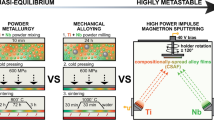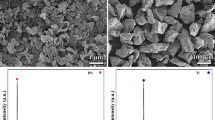Abstract
The study demonstrates an effective method to synthesize titanium-titanium boride (Ti-TiB) functionally graded material (FGM) tiles by exploiting the simultaneous TiB whisker formation in situ and the densification occurring during the reaction sintering process. The macrostructure of the graded material was designed to have a beta-titanium (β-Ti) layer on one side with the composite layers of Ti-TiB mixture having increasing volume fraction of the TiB through the thickness. The approach used an optimized tri-modal powder mixture consisting of α-Ti powder, a master alloy of the β-stabilizing-element powders (Fe-Mo), and TiB2. The structure and properties of both of these FGMs were systematically characterized by X-ray diffraction, electron microscopy, and microhardness measurements. Interestingly, it has been found that two different kinds of TiB whisker morphologies were observed in the FGMs. The Ti-rich layers were found to have large and pristine TiB whiskers uniformly distributed in the Ti matrix. On the other hand, the TiB-rich layer was found to have a network of interconnected and relatively smaller TiB whiskers appearing as clusters. The layers of intermediate TiB volume fractions were found to consist of both the morphologies of TiB. The effectiveness of the X-ray direct comparison method for the determination of volume fractions of phases in the FGM layers was also demonstrated. The Vickers microhardness level was found to increase dramatically from 420 kgf/mm2 in the β-Ti layer to 1600 kgf/mm2 in the TiB-rich layer. The elastic residual stresses retained in the graded layers after fabrication were determined based on an elastic multilayer model. The nature of microstructure, the hardness variation, and the distribution of residual stresses in these novel FGMs are discussed.
Similar content being viewed by others
References
R. Watanabe, A. Kawasaki, and H. Takahashi: in Mechanics and Mechanisms of Damage in Composites and Multi-Materials, D. Baptiste, ed., Mechanical Engineering Publications, London, 1991, pp. 285–99.
K. Ichikawa: Functionally Graded Materials in the 21st Century, Kluwer Academic Publishers, Dordrecht, The Netherlands, 2001, pp. 64–69.
K.S. Ravichandran: Mater. Sci. Eng., 1995, vol. A201, pp. 269–76.
A.E. Giannakopoulos, S. Suresh, M. Finot, and M. Oisson: Acta Metall. Mater., 1995, vol. 43, pp. 1335–44.
M. Koizumi: Ceram. Trans., 1992, vol. 34, pp. 1–10.
B. Sauhan, W. Luxem, M. Bartsch, M. Schmucker, and H. Schneider: Materials Science Forum, Proc. 5th Int. Symp. on Functionally Gradient Materials, Trans Tech Publications, Uetikonzuerich, Switzerland, 1999, vol. 308–311, pp. 47–52.
P. Nicolae: Materials Science Forum, Proc. 5th Int. Symp. on Functionally Gradient Materials, Trans Tech Publications, Uetikonzuerich, Switzerland, 1999, vols. 308–311, pp. 482–86.
F. Watari, A. Yokoyama, H. Matsuno, F. Saso, M. Uo, and T. Kawasaki: Materials Science Forum, Proc. 5th Int. Symp. on Functionally Gradient Materials, Trans Tech Publications, Uetikonzuerich, Switzerland, 1999, vol. 308–311, pp. 356–61.
W.A. Gooch, M.S. Burkins, R. Palicka, J. Rubin, and K.S. Ravichandran: Materials Science Forum, Proc. 5th Int. Symp. on Functionally Gradient Materials, Trans Tech Publications, Uetikonzuerich, Switzerland, 1999, vols. 308–311, pp. 614–21
S.S. Sahay, K.S. Ravi Chandran, R. Atri, B. Chen, and J. Rubin: J. Mater. Res., 1999, vol. 14, pp. 4214–23.
R.R. Atri, K.S. Ravichandran, and S.K. Jha: Mater. Sci. Eng., 1999, vol. A271, pp. 150–59.
A. Fan, P. Midownik, L. Chandrasekaran, and M. Ward-close: J. Mater. Sci., 1994, vol. 29, pp. 1127–34.
W.O. Soboyejo, R.J. Lederich, and S.M.L. Sastry: Acta Metall. Mater., 1994, vol. 42, pp. 2579–91.
R.R. Atri: Ph.D. Thesis, University of Utah, Salt Lake City, UT 2000.
ASM Handbook: Alloy Phase Diagrams, H. Baker, ed., ASM INTERNATIONAL, Materials Park, OH, 1992, vol. 3, pp. 2–85.
K.E. Spear, P. McDowell, and F. McMohan: J. Am. Ceram. Soc., 1986, vol. 69, pp. C-4–C-6.
HSC Chemistry for Windows, Ver. 1.10, Chemical Reaction and Equilibrium Software, A. Roine, ed., Outkumpu Research Oy, Pori, Finland, 1993.
K.B. Panda and K.S. Ravi Chandran: Metall. Mater. Trans. A, 2003, vol. 34A, pp. 1371–85.
U. Leushake, A.N. Winter, B.H. Rabin, and B.A. Corff: Materials Science Forum, Proc. 5th Int. Symp. on Functionally Gradient Materials, Trans Tech Publications, Uetikonzuerich, Switzerland, 1999, vols. 308–311, pp. 13–18.
R.M. German: Powder Metallurgy Science, 2nd ed., MPIF, Princeton, NJ, 1994, p. 166.
R.M. German: Powder Packing Characteristics, MPIF, Princeton, NJ, 1994, p. 183.
Z. Fan, Z.X. Guo, and B. Cantor: Composites, 1997, vol. 28A, pp. 131–40.
R.G. Munro: J. Res. Nat. Inst. Stand. Technol., 2000, vol. 105, pp. 709–20.
H. Itoh, S. Naka, T. Matsudaira, and H. Hamamoto: J. Mater. Sci., 1990, vol. 25, pp. 533–36.
B.D. Cullity: Elements of X-Ray Diffraction, 2nd ed., Addison-Wesley, Reading, MA.
P. Timoshenko and J.N. Goodier: Theory of Elasticity, 3rd ed., Mc-Graw-Hill, New York, NY, 1970, p. 433.
M. Gere and S.P. Timoshenko: Mechanics of Materials, 4th ed., PWS Publishing Co., Boston, MA, 1997, p. 57.
S.G. Lekhnitskii: Anisotropic Plates, translated from 2nd Russian edition, Gordon and Breach, New York, NY, 1968, pp. 74–84.
K. Wang, L. Gustavson, and J. Dumbleton: in Beta Titanium Alloys in the 1990’s, D. Eylon, R.R. Boyer, and D.A. Koss, eds., TMS, Warrendale, PA, 1993, p. 49–60
D.K. Balch, T.J. Fitzerald, V.J. Michaud, A. Mortensen, Y.L. Shen, and S. Suresh: Metall. Mater. Trans., A, 1996, vol. 27A, pp. 3700–13.
K.S. Ravichandran: J. Am. Ceram. Soc., 1994, vol. 77, pp. 1178–84.
P.K. Mallick: Fiber-Reinforced Composites: Materials Manufacturing and Design, Marcel Decker, Inc., Princeton, NJ, 1988, p. 129.
Author information
Authors and Affiliations
Rights and permissions
About this article
Cite this article
Panda, K.B., Ravi Chandran, K.S. Titanium-titanium boride (Ti-TiB) functionally graded materials through reaction sintering: Synthesis, microstructure, and properties. Metall Mater Trans A 34, 1993–2003 (2003). https://doi.org/10.1007/s11661-003-0164-3
Received:
Issue Date:
DOI: https://doi.org/10.1007/s11661-003-0164-3




